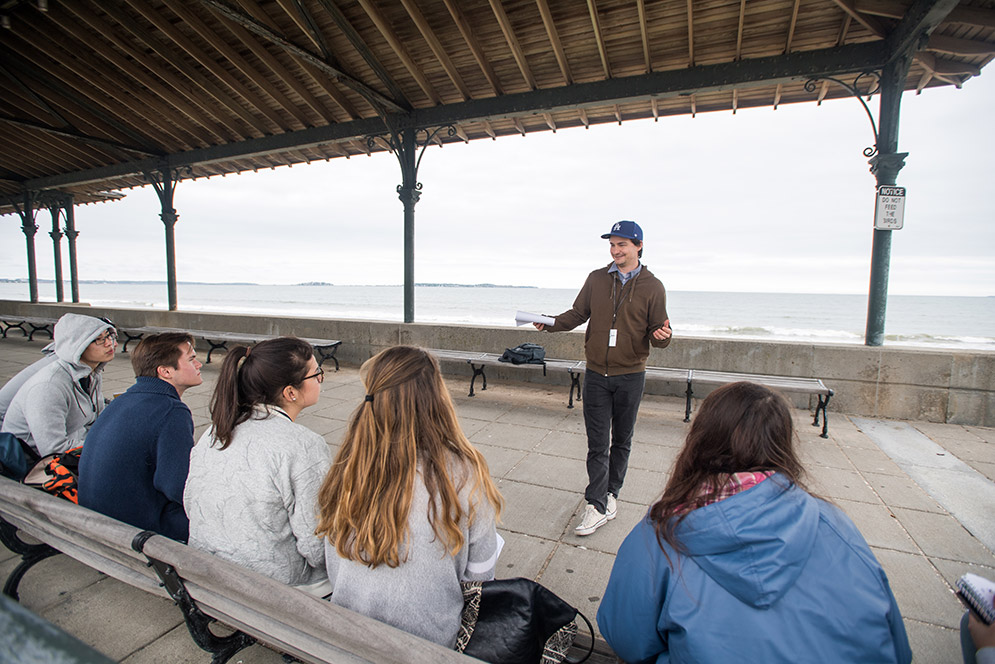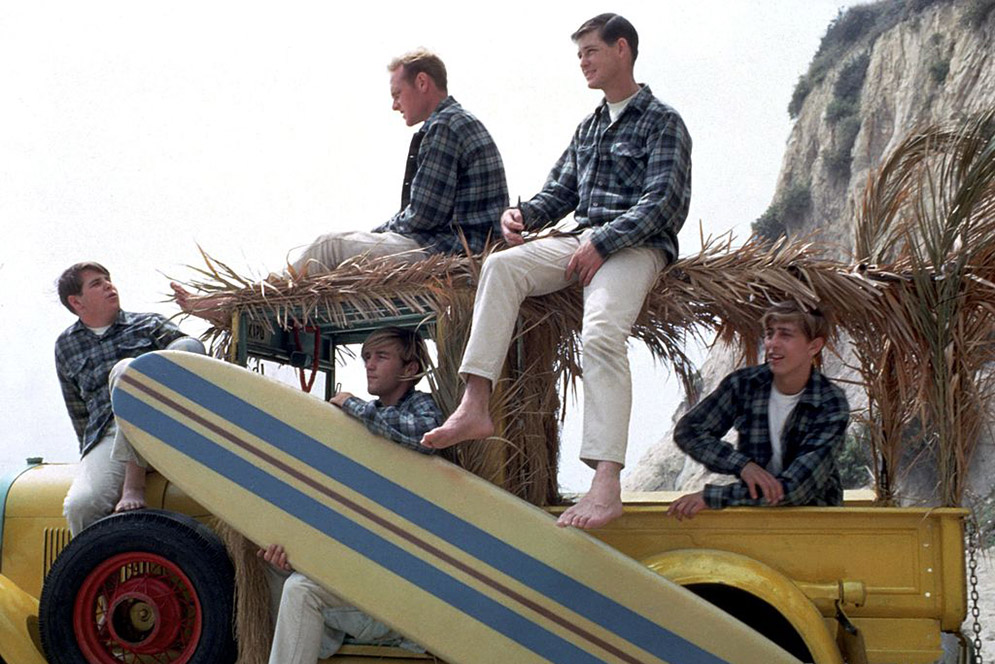A gray sky presses down on Revere Beach, and a chill wind blows in off the water. No one’s catching a wave, and the surf is barely knee-high anyway. The lone figure on the sand is a guy with a metal detector, prospecting for coins and not finding any.
“What don’t you see here?” graduate student Samuel Palfreyman (GRS’19) asks the students taking his Summer I Introduction to American Studies course, Life’s a Beach: The Beach Boys, Surfing, and the Influential 1960s Southern California Subculture.
“People,” someone says, and everyone laughs, including Palfreyman.
The instructor brought his students to Revere (“America’s First Public Beach,” says a sign) to get their toes in the sand and think about how beach culture has changed over the decades, and how it has changed us. But the weather didn’t read the syllabus, so no one is stretching out a blanket, and there is no sunbathing or Frisbee-playing, as hoped for. Instead, the class huddles in an open-air pavilion, fighting off hypothermia while they discuss the social dynamics of the beach here and in California.
The correct answer to Palfreyman’s question is “buildings.” The unbroken sweep of shore indicates how late-19th-century urban planners tried to provide the working class with a scenic and healthful antidote to crowded tenements and factories. The beaches of that day were usually close to public transportation, too, as Revere Beach is—the BU class arrived on the Blue Line, like generations of beachgoers before them. But after World War II, Americans became more suburban and middle class, traveled mostly by automobile, and began to demand a different sort of leisure, especially as the number of teenage baby boomers grew.
“My grandmother and my uncles all remember coming here and going on the rollercoaster,” says history major and Massachusetts native Annie Killelea (CAS’17). “Everyone remembers it as this amazing place. But as soon as they could afford to go somewhere else, they did.”
Each class session is denoted in the syllabus with a song title from the Beach Boys’ Endless Summer greatest-hits collection, from “Catch A Wave” to “I Get Around” to “God Only Knows.” Surfing itself spread rapidly from its early, somewhat disreputable SoCal origins, thanks to its innate allure and bikini-beach-party movies and TV shows of the early and mid-1960s. By 1966, there were 50,000 surfers on the East Coast, Palfreyman told the class. Now there are several times that, and you can see them up and down the New England coast when the surf’s up. Palfreyman notes that he was surprised to find them even in Maine’s Acadia National Park. But the course, Life’s a Beach, is less about the sport and more about its cultural influence.
“What I’m really trying to investigate is, how did this subculture coming out of Southern California—appropriating from Hawaii and the music of African Americans—come to resonate with people all over, including back here in New England,” he says.

American studies graduate student Samuel Palfreyman (GRS’20) took the students in his Life’s a Beach course to the sand in Revere, but the weather didn’t cooperate. Photo by Cydney Scott
Palfreyman believes that you can still see it now in ads using the image of a surfer to denote freedom and leisure, the modern American version of the pursuit of happiness. Even if they’re worn down by the weekly commute, half of the suburban dads at every Home Depot on any given Saturday afternoon wear flip-flops and baggy shorts as if on their way to hang 10 at Malibu. The rise of teenage consumer culture, car culture, and the transformative move to franchised, car-centric fast-food dining were all driven by suburban demographics, turbocharged by the golden-California myth. And while surf culture was in part an apolitical detour from the upheavals of the 1960s, it also promoted tolerance and an unconventional spirituality—California Zen—that proliferated into the 1970s and beyond. Palfreyman says surfing culture was also a driver of the environmental ethos that sprang from the 1960s—if you’re living the beach lifestyle, water and air pollution are immediate concerns.
“It’s a California state of mind, and now it’s all over the US,” says psychology major Julia Tordo (CAS’19).
Despite the fact that he’s a Southern Californian to the bone, raised in Laguna Beach from the age of eight, Palfreyman seems unaffected by the cold. He waxes nostalgic about the countless hours he and his brother spent on Victoria Cove, a hundred yards from their home in a gated community called Blue Lagoon. “I can get up and turn on a wave, but I’m not winning any competitions,” he says. His mother, now a grandmother, still surfs.
He says he basically lived in flip-flops right through college. “I definitely have a mixed relationship with growing up in California beach culture,” he says. “It’s very relaxing, very nice. But it also breeds these myths of eternal summer that just aren’t true and can get people a little bit stuck.”
Palfreyman double-majored in architecture and American studies at the University of California, Berkeley, and his dissertation is on mid-20th-century Mormon architecture across the US. He is a practicing Mormon, and his family has deep Utah roots—not exactly stereotypical surf-bum material.
“Mormons in board shorts is definitely a thing,” he says with a smile, but “there’s more diversity in anything you take a close look into.” Working in American studies is an opportunity to examine that sort of cultural contrast, he says.
“Putting together the syllabus made me think critically for the first time about Beach Boys lyrics and how this music is often frowned upon as not ‘real’ rock and roll,” Palfreyman says. By the late 60s, the group had been eclipsed by the more ambitious, farther-out rock of the Woodstock generation, while the Beach Boys were often regarded as a squarish nostalgia act. But they have endured. The brilliance of leader and cofounder Brian Wilson has been increasingly recognized with the passing years, and by the time the class gets to Revere Beach, the students know enough to smile sardonically at mention of the group’s famously egocentric and commercially minded Mike Love. But Palfreyman encourages them to widen their cultural lens.
“We don’t always think about where our culture and norms come from, so these discussions are really fascinating to me,” says Tordo. “I’ve decided to write my paper on the history of swimwear and its implications on sexism and sexualization of the beach and beach culture, and its role in creating today’s standards of beauty for both women and men. Fashion seems like such a trivial subject on the surface, but I think it actually has an important role in our history and our cultural views today.”
In addition to Revere Beach, locations the class will visit include the Mendon Twin Drive-In movie theater (which screened Baywatch, no less) and Newbury Street boutiques where the beach look enjoys a seemingly endless summer. Unfortunately, Brian Wilson doesn’t perform in New England until September, and the Love-led Beach Boys of today don’t arrive till August, when they play at Hampton Beach.
But you don’t have to hear “All Summer Long” live to understand the subculture: Palfreyman has never seen the Beach Boys in concert.















































Related Stories
A Day at the (BU) Beach
No sand, but still a popular destination
What’s Happening to the BU Beach?
Construction on Admissions Reception Center, School of Law
Recalling the Music and Mayhem of Los Angeles in the ’60s
COM professor’s book digs into Beach Boys and Charles Manson
Post Your Comment